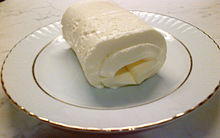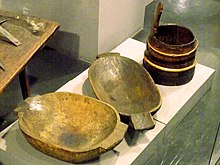Kaymak
![]()
The title of this article is ambiguous. For other meanings, see Kaymak (disambiguation).
Kaymak or kaymak (Bulgarian and Russian Каймак, Turkish kaymak) is a dairy product made from cow's milk, buffalo milk, sheep's milk or goat's milk; cow's milk is the preferred milk in present-day Bulgaria and Serbia, while buffalo milk or sheep's milk is used in Turkey and other eastern countries. After milking, the milk is heated for several hours. The top layer of cream produced during heating is then skimmed off in several stages.
It is layered cream in the true sense of the word. It is used as a snack or side dish when stored in a cool place, both for sweets such as baklava and for hearty dishes such as Ćevapi. You can buy artisanal kaymak in markets, but it is also produced and packaged industrially. Clotted cream is a similar product from England. English travellers as well as a letter to the editor in an English scientific magazine in 1869 pointed out the similarity of kaymak with clotted cream as early as the nineteenth century.
The term comes from Old Turkish and means 'fat-rich substance floating on the surface of heated milk'. In Greek, the foreign word kaymaki refers on the one hand to layered cream, but also to milk foam in general. Likewise in Bulgarian, where kaymak today denotes both layered cream or cream and the foam that forms in the preparation of, say, coffee or cappuccino. In a figurative sense, kaymak can also generally mean "the best part" of something or "the icing on the cake" (see the quote from Karl Koch in "Zeugnissen aus Reiseberichten").
Kaymak is used in the cuisine of Turkey and in some national cuisines of the Balkans as well as in various countries of the Orient and the Middle East.

Kaymak of Turkey

Traditional pots for making kaymak in the Balkans

Kaymak from Montenegro
Testimonials from travelogues
- The German writer Christian August Fischer (1771-1829) probably stayed in Constantinople before 1800. In 1824, his memoir Hyacinths Drawn in My Dungeon was published, which devotes a chapter to a stay in Turkey under the title "The Epicurean at Constantinople". In it there is a detailed description of kaymak: "Kaimack means as much as cream skin. The milk is left to boil and the thick fat skin that forms is removed from time to time. This is then arranged in layers, each of which is sprinkled heavily with sugar, then pressed into fine, white glazed pots and shipped in this way. The best kaimak comes from Scutari; but it is a very difficult dish to digest."
- The diplomat William Turner (1792-1867), who had worked at the British embassy in Constantinople since 1811, undertook an extensive journey through Palestine, Egypt and Greece in 1815. On his return to Great Britain (1816) he wrote a three-volume description of his travels, which was published in London in 1820. In the second volume of this description of his travels we find a short note on Kaymak, written in Acre and dated 9 April 1815: "Milk, I am delighted to find, abounds in Acre, even that of cows (for the milk of goats is most common in Syria), so that I am revealing in Yaourt and Kaimac: the latter is a preparation of coagulated milk, not unlike our Devonshire clotted cream. "I am pleased to find that milk is plentiful in Acre, even cow's milk (for goat's milk is most common in Syria), so that I am revelling in Yaourt and Kaymak: the latter is a preparation of coagulated milk, not unlike our Devonshire clotted cream").
- Karl Ludwig Freiherr von Stürmer (1792-1853) stayed in 1816 during a trip to Constantinople in the Bulgarian Ajtos (then part of the Ottoman Empire). There he was served an egg dish in a tavern, which he describes as follows: "A rice soup was served; then an egg dish, which I found so excellent that I believed the cause of it could not only be subjective in my ravenous appetite, but must also be objectively founded in a special method of preparation. I inquired about this; I was told that kaimac had been added instead of butter, as is usually done. This is a milk that has been boiled for a long time - I believe 20 hours - and is so concentrated that it can be cut. It is also enjoyed with sugar and other ingredients."
- The English poet and traveler Julia Pardoe (from Yorkshire, 1806-1862) was in Constantinople in 1836 and later reported that kaymak was sold at the "confect market" there. In her book Views of the Bosphorus and Constantinople (English original edition: The Beauties of the Bosphorus, 1839), Pardoe writes that "kaymak" is "curdled milk", and notes that "in the luxuriant Orient" there is hardly "a finer food". She then says, "Its name Kaimac means 'the highest excellence' in the Turkish language, and shows how much people here love this delicacy. It is a pleasure to see people thronging for the table on which it is displayed quite fresh for sale."
- In the first volume of Wanderungen im Oriente (Weimar 1846), the German naturalist Karl H. Koch reports on his stay in Constantinople in 1843, where he describes, among other things, the custom of smoking the reed or long pipe. In this context he explains a special meaning of the word kaymak: "As soon as the upper part of the tobacco, which the Turk calls 'cream' (kaimak), has been smoked, the gentleman quietly puts the pipe aside and has another brought to him or has his filled anew with tobacco." Here, then, we meet with the metaphorical use of the word, which in this case denotes "the best part" or "the icing on the cake" of something.
- The Russian traveller M. Kittara stayed in a Kyrgyz camp in July 1846. His report on this, which first appeared in German in 1850 under the title Ein kirgisischer Tui and was later reprinted in other publications, contains the following passage: "The tea was, as usual, very diluted and then placed on an old presentation plate [...] Two of the cups were provided with copper tea spoons, whose bent shape, cloudy appearance, and black and yellow stains testified to long, unclean use, but in the other two cups, since there was a lack of spoons, small scoops freshly cut from wood were placed as a surrogate. In addition, there was a moderately large bowl of sugar and a large jar of k a i m a k on the presenter's plate. This is the name of a dish that is considered by the Kyrgyz to be one of their main delicacies. It consists of boiled cream that has been boiled for a long time and has become extremely thick, almost buttery, and is covered with a skin that has formed during the boiling process. The kaimak is very tasty but so fatty that it would be better to use it as a separate dish and not as an addition to tea."
- In the third volume of his travel book published in 1851, the English cleric Henry Christmas (1811-1868) also mentions kaymak, specifically in the chapter on Turkish desserts and sweets. There it says: "One favourite dish is composed of milk thickened and sweetened, with some aromatic flavouring, and small pieces of the breasts or wings of chickens imbedded in it; this is seen filling innumerable small pans on the shopboard of the capital, alternating with a sort of pancake made of flour and honey, which is eaten with "kaimac", or clotted cream; preparations of transparent sugar are sold by itinerant venders, whose trade is a profitable one. ”
- The French illustrator Théophile Deyrolle (1844-1923) travelled through Georgia and Armenia in 1863 on behalf of the Paris Société de Géographie. His reportage, rich in detail and with many illustrations, was published in many installments in the French magazine Le Tour du Monde - Nouveau Journal des Voyages from 1869 onwards. The magazine Globus published a German abridged version of it in several parts, which was printed under the title "In Turkish Armenia". In the third part of the German version (1876), the following can be read: "Deyrolle's night quarters in Cheverme, a village of 40 houses, was, however, one of the best he encountered on his entire journey [...] Immediately upon his arrival, he was offered a delicious dish of kaimak and wonderful white honey. Kaimak, next to ya'urt or sour milk, forms the staple food of the people in these cattle-rich mountains; it is thick, fat cream, which remains when a good portion of milk is kept tepid for some hours in a copper vessel." In another article published in the Globe as early as 1875, also based on Deyrolle's travelogue, Kaymak is also mentioned: "Beyond Gümüsch Chane, Deyrolle spoke in a pretty monastery [...] Below the church lie the agricultural buildings; the herds of goats and sheep give excellent milk, from which butter and cheese are made, then also cream, kaïmack; that is why such a homestead is called kaïmackli."
Search within the encyclopedia